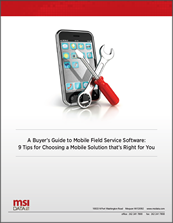Is BYOD right for your organization? We explore the risks and benefits of this hot-topic in mobile field services.
There is no ignoring the buzz about the latest trend in field service, BOYD (bring-your-own-device). However, with BYOD’s recent spike in popularity, we can’t help but wonder: what’s all the hype about?
BYOD is a policy that allows your employees to bring their own smartphones, tablets, and laptops into the workplace. While today only 6% of employers have implemented a variation of a BYOD program or policy, according to a recent Gartner study, that number will increase approximately 65% by 2017.
An attractive feature of BYOD is the shift in cost responsibility from you to your employees resulting in major savings. BYOD also stimulates employee happiness, user enhancement, and productivity because your employees are able to use technology they already own and love.
A low cost and happy employees? Is BYOD too good to be true?
As you probably guessed, there are some risks involved in switching to a BYOD policy. Security threats, a strain on the IT department, and the potential inability to run cross-platform are few of the most deterring.
Read on as we dive deeper into pros and cons of this much-hyped solution.
Benefits of BYOD Policy
- Reduce Technology Costs for Field Service Firms: As previously mentioned, cost savings is a major advantage of BYOD. BYOD virtually allows you to forgo all technology device costs, including all upfront costs on the devices themselves, maintenance costs, and monthly service fees.
- Improve User Enhancement: Employee user enhancement is also an attractive feature of BYOD. By giving your employees the option to work from their personal devices, user enhancement increases, which is directly correlated with productivity: the more your technicians use their devices, the more productive they are.
- Retain Happy Employees: When technicians are able to use the devices they already know and love, they will be happier working for your company and when experienced employees are happy, they’re easier to retain.
Why BYOD can be Risky
While there are many benefits to adopting BYOD, there are some downsides that you should consider before jumping in head-first.
- Security: Security is one of the most discouraging factors of BYOD. Due to their size and portability, mobile devices are prone to being left behind on work sites, compromising your company’s data. Because all your employees are working on their own devices, features such as security, antivirus, and anti-malware protection are not standard. This creates a strain on your IT department to maintain your company’s protection since it makes It responsible for employing precautionary measures such as registration requirements and password protection.
- Difficult transition if your app isn’t cross platform: If the app you’re using doesn’t run cross-platform, beginning a BYOD policy will be nearly impossible without switching software providers. In BYOD, your employees’ devices serve in both business and personal use, and consequently, you cannot force your employees to use a certain type of device or platform.
- End user support: If you purchase an application outright, without a support contract, you may run across expensive support costs and IT training required to support software in house. An easy solution to this problem is to purchase your software as a service (SaaS) and rely on your provider to maintain the application in case of difficulties.
Cross-platform field service apps make BYOD possible
The ability to run cross- platform when implementing BYOD is essential. With the presence of multiple operating systems including iOS, Android, and Windows, your mobile software solution must be able to perform on all systems in order for BYOD to be successfully implemented.
Cross-platform mobile applications support improved technician, inspector, and other field worker productivity. These applications automate work assignments, status, alerts, mapping and work order management, mobile asset tracking, parts warranty, tasks, service history, labor time, audits, sales, collections, signature capture, photo and video capture, and inspections on all operating systems.
What BYOD Trends Mean for You Today
Whether your company is thinking of moving toward a BYOD policy or not, it’s important to acknowledge the trend’s increasing relevance. The key to your company’s success in BYOD is its cross-platform capability. Even if you don’t plan on implementing the policy now, cross platform is the only way to go if you want the option of adopting BYOD down the road, or even if you see yourself switching providers at any point.
A Buyer’s Guide to Mobile Field Service Software: 9 Tips for Choosing a Mobile Solution
In the market for a cross-platform mobile app for your field service organization? Learn important tips, guiding questions, and to-dos in our free, educational whitepaper: “A Buyer’s Guide to Mobile Field Service Software: 9 Tips for Choosing a Mobile Solution that’s Right for You.”
Download the Guide
Like this post? Subscribe to our Field Service Management Blog for original weekly content updates.

